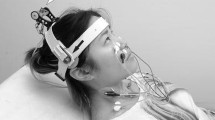Abstract
The vestibulo-ocular reflex rotates the eye about the axis of a head rotation at the same speed but in the opposite direction to make the visual axes in space independent of head motion. This reflex works in all three degrees of freedom: roll, pitch, and yaw. The rotations may be described by vectors and the reflex by a transformation in the form of a matrix. The reflex consists of three parts: sensory, central, and motor. The transduction of head rotation into three neural signals, which may also be described by a vector, is described by a canal matrix. The neural, motorcommand vector is transformed to an eye rotation by a muscle matrix. Since these two matrices are known, one can solve for the central matrix which gives the strength of the connections between all the vestibular neurons and all the eye-muscle motoneurons. The role of the metric tensor in these transformations is described. This method of analysis is used in three applications. A lesion may be simulated by altering the elements in any or all of the three component matrices. By matrix multiplication, the resulting abnormal behavior of the reflex can be described quantitatively in all degrees of freedom. The method is also used to directly compare the differences in brain-stem connections between humans and rabbits that accommodate the altered actions of the muscles of the two species. Finally the method allows a quantitative assessment of the changes that take place in the brainstem connections when plastic changes are induced by artificially dissociating head movements from apparent motion of the visual environment.
Similar content being viewed by others
References
Barr, C.C., Schultheis, L.W., Robinson, D.A.: Voluntary, non-visual control of the human vestibulo-ocular reflex. Acta Oto-Laryngol.81, 365–375 (1976)
Berthoz, A., Melvill Jones, G., Bégué, A.E.: Differential visual adaptation of vertical canal-dependent vestibulo-ocular reflexes. Exp. Brain Res.44, 19–26 (1981)
Blanks, R.H.I., Curthoys, I.S., Markham, C.H.: Planar relationships of the semi-circular canals in man. Acta Oto-Laryngol.80, 185–196 (1975)
Gonshor, A., Melvill Jones, G.: Extreme vestibulo-ocular adaptation induced by prolonged optical reversal of vision. J. Physiol.256, 381–414 (1976)
Hay, J.: Visual adaptation to an altered correlation between eye movement and head movement. Science160, 429–430 (1968)
Ito, M., Shiida, T., Yagi, N., Yamamoto, M.: The cerebellar modification of rabbit's horizontal vestibulo-ocular reflex induced by sustained head rotation combined with visual stimulation. Proc. Jpn. Acad.50, 85–89 (1974)
Mano, N., Oshima, T., Shimazu, H.: Inhibitory commissural fibers interconnecting the bilateral vestibular nuclei. Brain Res.8, 378–382 (1968)
Miles, F.A., Fuller, J.H.: Adaptive plasticity in the vestibulo-ocular responses of the rhesus monkey. Brain. Res.80, 512–516 (1974)
Pellionisz, A., Llinás, R.: Cerebellar coordination: Covariant analysis and contra-variant synthesis via metric tensor. A tensorial approach to the geometry of brain function. Soc. Neurosci. Abstr.5, 105 (1979)
Pellionisz, A., Llinás, R.: Tensorial representation of space-time in CNS: Sensory-motor coordination via distributed cerebellar space-time metric. Soc. Neurosci. Abstr.6, 510 (1980a)
Pellionisz, A., Llinás, R.: Tensorial approach to the geometry of brain function: Cerebellar coordination via a metric tensor. Neurosci.5, 1125–1136 (1980b)
Robinson, D.A.: A quantitative analysis of extraocular muscle cooperation and squint. Invest. Ophthalmol.14, 801–825 (1975)
Robinson, D.A.: Adaptive gain control of vestibulo-ocular reflex by the cerebellum. J. Neurophysiol.39, 954–969 (1976)
Schultheis, L.W., Robinson, D.A.: Directional plasticity of the vestibulo-ocular reflex in the cat. In: Vestibular and oculomotor physiology. International Meeting of the Bárány Society, pp. 504–512. Cohen, B. (ed.) New York: New York Academy of Sciences 1981
Shimazu, H., Precht, W.: Inhibition of central vestibular neurons from the contralateral labyrinth and its mediating pathway. J. Neurophysiol.29, 467–492 (1966)
Simpson, J.I., Graf, W.: Eye-muscle geometry and compensatory eye movements in lateral-eyed and frontal-eyed animals. In: Vestibular and oculomotor physiology. International Meeting of the Bárány Society, pp. 20–30. Cohen, B. (ed.). New York: New York Academy of Sciences 1981
Simpson, J.I., Graf, W., Leonard, C.: The coordinate system of visual climbing fibers to the flocculus. In: Progress in oculomotor research, pp. 475–484. Fuchs, A.F., Becker, W. (eds.). New York: Elsevier 1981a
Simpson, J.I., Graf, W., Leonard, C.S.: Spatial coordinates of visual messages in the flocculus. Soc Neurosci. Abstr.7, 133 (1981b)
Wilson, V.J., Melvill Jones, G.: Mammalian vestibular physiology. New York: Plenum Press 1979
Author information
Authors and Affiliations
Rights and permissions
About this article
Cite this article
Robinson, D.A. The use of matrices in analyzing the three-dimensional behavior of the vestibulo-ocular reflex. Biol. Cybern. 46, 53–66 (1982). https://doi.org/10.1007/BF00335351
Received:
Issue Date:
DOI: https://doi.org/10.1007/BF00335351




